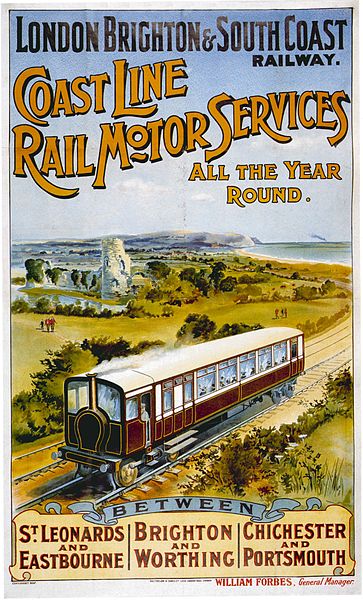The South London line is a railway line in inner south London, England. The initial steam passenger service on the route was established by the London, Brighton and South Coast Railway (LBSCR) on 1 May 1867 when the central London terminal stations of Victoria and London Bridge were connected to the inner south London suburbs of Battersea, Clapham, Brixton, Camberwell and Peckham. A pioneer of overhead electric traction, most of the line was built on high level viaducts and was marketed as the South London Elevated Electric Railway in the early part of the 20th century. The electric service was popular, with four trains per hour and 12 million passengers in 1920. Between Wandsworth Road and Peckham Rye the route ran parallel to another set of tracks. Prior to 1923, both lines from Wandsworth Road to East Brixton were owned by the London, Chatham and Dover Railway (LCDR) and the lines from East Brixton to Peckham Rye were owned by the LBSCR. The southern Atlantic lines were operated by the LBSCR and the northern Chatham lines were operated by the LCDR.

A London Overground train at Clapham High Street
High level bridge carrying the South London line through Brixton
A Southern train at Denmark Hill in 2009
Victoria to Wandsworth Road (1912)
London, Brighton and South Coast Railway
The London, Brighton and South Coast Railway was a railway company in the United Kingdom from 1846 to 1922. Its territory formed a rough triangle, with London at its apex, practically the whole coastline of Sussex as its base, and a large part of Surrey. It was bounded on its western side by the London and South Western Railway (L&SWR), which provided an alternative route to Portsmouth. On its eastern side the LB&SCR was bounded by the South Eastern Railway (SER)—later one component of the South Eastern and Chatham Railway (SE&CR)—which provided an alternative route to Bexhill, St Leonards-on-Sea, and Hastings. The LB&SCR had the most direct routes from London to the south coast seaside resorts of Brighton, Eastbourne, Worthing, Littlehampton and Bognor Regis, and to the ports of Newhaven and Shoreham-by-Sea. It served the inland towns and cities of Chichester, Horsham, East Grinstead and Lewes, and jointly served Croydon, Tunbridge Wells, Dorking and Guildford. At the London end was a complicated suburban and outer-suburban network of lines emanating from London Bridge and Victoria, and shared interests in two cross-London lines.

The LB&SCR armorial device
The LB&SCR War Memorial, London Victoria Station
A LB&SCR poster advertising the Isle of Wight
1906 poster advertising rail motor services








